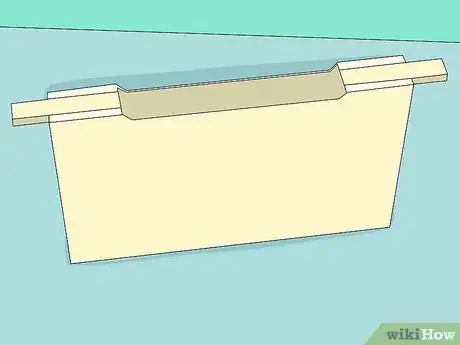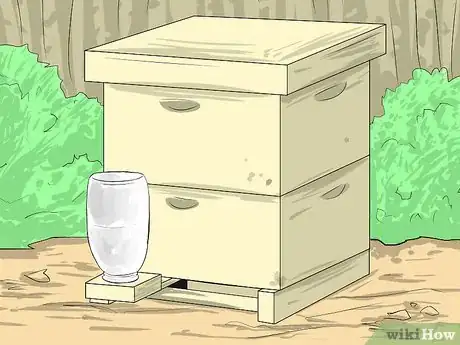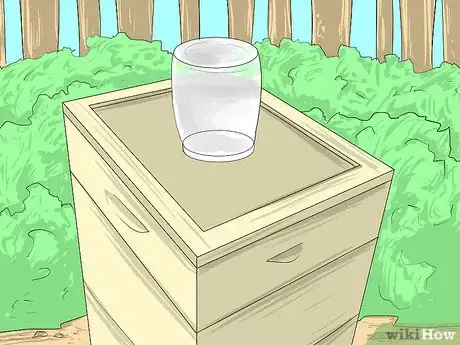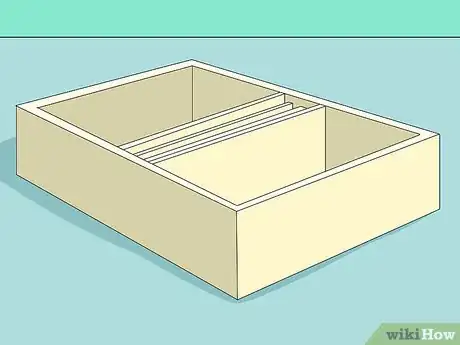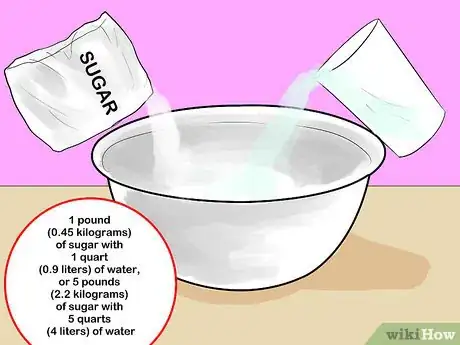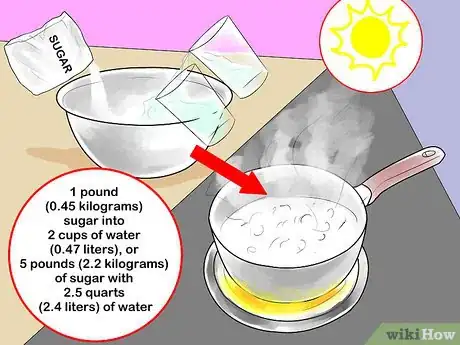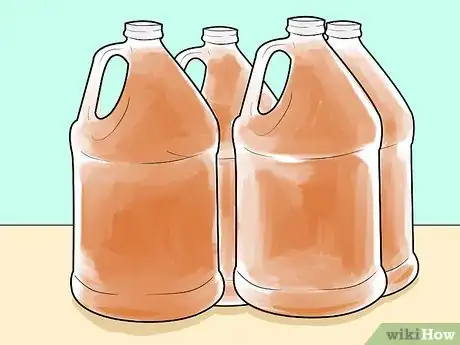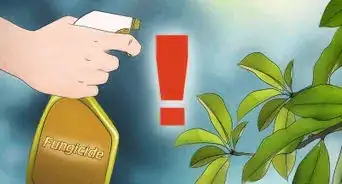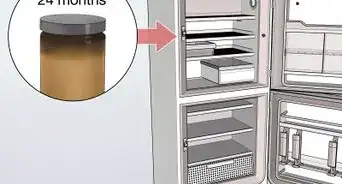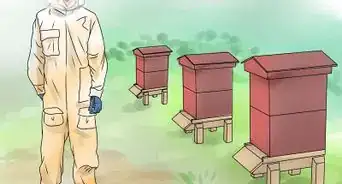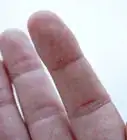This article was co-authored by David Williams. David Williams is a Professional Beekeeper and Bee Removal Specialist with over 28 years of beekeeping experience. He is the Owner of Bzz Bee Removal, a bee removal company based in the San Francisco Bay Area. Bzz Bee Removal locates, captures, and transports bees to local beekeepers to prevent colony collapse disorder.
This article has been viewed 48,512 times.
It’s usually best to let bees gather their own food. However, you can create your own feed for the bees if for some reason there are inadequate sources of honey, abnormalities in the environment, or for any other reason the bees are not able to feed on their own.[1] There are many types of feeders, sugar combinations in feeds, and times of year to think about when feeding.[2]
Steps
Choosing a Feeder
-
1Pick a frame feeder. This is the most common feeder to use. These can be wood or plastic. You want to pick a feeder in the 1-2 gallon range. Some models come with coarse siding to let the bees climb along the sides. Other models have features such as floats to prevent the bees from drowning if water collects inside. You can also find models that are portioned into multiple frames that allow access for multiple hives. Look for ease of access for yourself including the ability to open up the feeder to change spoiled feed.[3]
- If you go with the frame feeder you’ll need to fill it correctly. Get a funnel (metal or plastic) or make your own funnel out of thick paper. Hover the funnel over the chambers, and slowly pour the syrup feed until the brood chambers in the feeder are just short of full.
-
2Try a Boardman feeder. If you’re worried about bees drowning, then use this instead of the frame or Miller feeders. These wood feeders are shaped roughly like a large box. They hold an upside-down mason jar full of the feed you intend to use. You put the jar in the entrance, and the bees wander up into the jar for the syrup. These are easy to monitor, but you will have to shake off the bees from the jar to refill it.[4]Advertisement
-
3Get an inverted feeder. These are watercooler-sized wood feeders that work with inverted mason jars or metal cans full of feed. You place the jar of feed into the top entrance upside-down so the bees can fly into it. You can cover the entrance rim in #8 hardware cloth to prevent bees from hovering around the jar when you need to refill it.[5]
- This feeder poses less of a drowning risk to the bees.
-
4Set up a Miller feeder. If you are interested in handling more bees than the other feeders, then use this model. These are plywood feeders named after C.C. Miller. These feeders are much larger than average feeders with feed capacities typically up to 5 gallons. Miller feeders can have open access so the hive can fly throughout the feeder, or partitioned access so the bees can only get to the syrup. These partitions are really just trays with slots for bee access. But the trays need tight seals so foreign bees don’t drown in the syrup. You can pour the syrup into the trays at the ends, center, or all frames.[6]
- These feeders can stack taller to hold more syrup, but may get used less by the bees leading to spoiling of the feed.
Preparing to Enter the Feeder
-
1Wear a beekeeper suit.[7] You’ll need to purchase a cotton-based suit for comfort. It will need to have several features to allow you free range of motion, but keep out bees. Look for a suit that has leg zippers, knee pads, gusseted crotch, elastic wrists, and a double-ended main zipper. You’ll also need the suit to come with plenty of pockets including a holster for hive tools. The suit should have metal D-rings to tie down the mask or veil tie. Most suits are sting resistant, and not completely sting proof.[8]
- Suit prices can vary depending on features and fabric quality. Some models can be $20 if you buy just a jacket and head covering. Some full suits can be upwards of $100.
-
2Smoke the bees before opening a feeder. Light the smoker with a standard cigarette lighter or match applied to the kindling in the main container, but don’t let it get excessively hot. Puff only one or two spurts of smoke in entrance and along the top of the feeder to disarm the bees’ alert pheromones. Wait one full minute after the puffs before opening the hive. If you notice the bees are still agitated, only then use an extra puff or two.[9]
- Some models come with liquid fuel, and a bellows attached. Follow the model’s instructions for lighting.
- You’ll also need a metal prying tool to open the feeder.
Mixing up Syrups
-
1Mix one part sugar and two parts water to stimulate egg laying. Combine 1 pound (0.45 kilograms) of sugar with 1 quart (0.9 liters) of water, or 5 pounds (2.2 kilograms) of sugar with 5 quarts (4 liters) of water. Stir the sugar into the warm water until dissolved.[10]
- Use this when there is enough honey available for the brood to feed on.
-
2Mix one part sugar and one part water to promote honeycomb building. You can feed this to bees in the spring or summer. Pour 1 pound (0.45 kilograms) sugar into 2 cups of water (0.47 liters), or 5 pounds (2.2 kilograms) of sugar with 2.5 US quarts (2,000 ml) (2.4 liters) of water. Bring the water to a boil, and turn off the heat source. Stir in the sugar until dissolved and let it cool.[11]
-
3Mix two parts sugar with one part water to save food for the winter. Do this in the autumn. Combine 1 pound (0.45 kilograms) of sugar with 1 cup (0.23 liters) of water, or 5 pounds (2.2 kilograms) of sugar with 5 cups (1.15 liters) of water. Boil the water, and stir in the sugar. Stir the sugar until the crystals dissolve. Remove the mixture from the heat, and let it cool.[12]
Planning a Schedule
-
1Set up supplies for winter first. Winter is the time that will be hardest to help bees that are starving.[13] Start preparing and feeding the syrup recipes in August or September. You can wait until October, but waiting until December is risky. Though you should still attempt to feed the bees rather than allow them to starve.[14]
- The amount of feed to store for winter is something you should ask your local beekeepers.
-
2Mix spring recipes. Use the seasonally mixed syrups for longer term feeding or to boost the life of a new hive. Prepare 2-4 gallons of syrup early so you can start these syrup feedings in May. Introduce this syrup at the start of a new hive.
- Once the hive is well underway, don’t over feed.
-
3Feed in times of need. Extra feeding should generally be done only when the hive is undersized or starving to begin with. Your batches of syrup may spoil if you’ve prepared much more than the bees need.[15]
- For example, if you have a hive that is supposed to weigh 150 pounds suddenly weighing 75 pounds, then it may be time to feed.
Expert Q&A
-
QuestionIs it okay to feed bees sugar water?
 David WilliamsDavid Williams is a Professional Beekeeper and Bee Removal Specialist with over 28 years of beekeeping experience. He is the Owner of Bzz Bee Removal, a bee removal company based in the San Francisco Bay Area. Bzz Bee Removal locates, captures, and transports bees to local beekeepers to prevent colony collapse disorder.
David WilliamsDavid Williams is a Professional Beekeeper and Bee Removal Specialist with over 28 years of beekeeping experience. He is the Owner of Bzz Bee Removal, a bee removal company based in the San Francisco Bay Area. Bzz Bee Removal locates, captures, and transports bees to local beekeepers to prevent colony collapse disorder.
Beekeeper & Bee Removal Specialist You absolutely can feed bees sugar water, especially if you need to keep them over a cold winter or when there aren't any natural sources of food.
You absolutely can feed bees sugar water, especially if you need to keep them over a cold winter or when there aren't any natural sources of food. -
QuestionHow do I give the bees water?
 Community AnswerMaking a water feeder for bees is as easy as filling a pie pan with marbles and water.
Community AnswerMaking a water feeder for bees is as easy as filling a pie pan with marbles and water. -
QuestionWithout a bee box, if I am using a planter or raising bees other than honeybees, how would I feed the bees?
 MarkloiuslejanoCommunity AnswerPlant nectar and pollen-rich flowers. They will keep your bees well-fed and happy.
MarkloiuslejanoCommunity AnswerPlant nectar and pollen-rich flowers. They will keep your bees well-fed and happy.
Warnings
- Smokers are fire hazards. Use extreme caution when lighting them.⧼thumbs_response⧽
- Bees can drown in feeders.⧼thumbs_response⧽
- Don’t over feed if the hive is at a healthy size.⧼thumbs_response⧽
- Bees from other hives can rob feed from your feeders.⧼thumbs_response⧽
- Top-opening feeders and mason jars are prone to attracting wildlife.⧼thumbs_response⧽
References
- ↑ David Williams. Beekeeper & Bee Removal Specialist. Expert Interview. 13 February 2020.
- ↑ http://www.bushfarms.com/beesfeeding.htm
- ↑ http://www.bushfarms.com/beesfeeding.htm
- ↑ http://www.bushfarms.com/beesfeeding.htm
- ↑ http://www.bushfarms.com/beesfeeding.htm
- ↑ http://www.bushfarms.com/beesfeeding.htm
- ↑ David Williams. Beekeeper & Bee Removal Specialist. Expert Interview. 13 February 2020.
- ↑ http://www.amazon.com/s/ref=nb_sb_ss_i_3_5?url=search-alias%3Dkitchen&field-keywords=beekeeping+suit&sprefix=beeke%2Ckitchen%2C143
- ↑ http://www.bushfarms.com/beessmoke.htm
- ↑ http://www.beekeepersguild.org/index.php?option=com_content&view=article&id=29&Itemid=49
- ↑ http://www.beekeepersguild.org/index.php?option=com_content&view=article&id=29&Itemid=49
- ↑ http://www.beekeepersguild.org/index.php?option=com_content&view=article&id=29&Itemid=49
- ↑ David Williams. Beekeeper & Bee Removal Specialist. Expert Interview. 13 February 2020.
- ↑ http://www.bushfarms.com/beesfeeding.htm
- ↑ http://www.bushfarms.com/beesfeeding.htm
About This Article
To feed bees, start by mixing equal parts sugar and water in a saucepan and bringing it to a boil to make a syrup. Alternatively, add more water to stimulate egg-laying, or less water to help the bees save food for the winter. Once the syrup cools, store it in gallon jugs until you’re ready to use it. Then, put on a beekeeper suit to protect yourself from stings and use a smoker to puff smoke into the hive, which will sedate the bees. Next, funnel the syrup into the feeder chambers until they are almost full. For advice on how to choose the type of feeder that’s right for your hive, read on!

